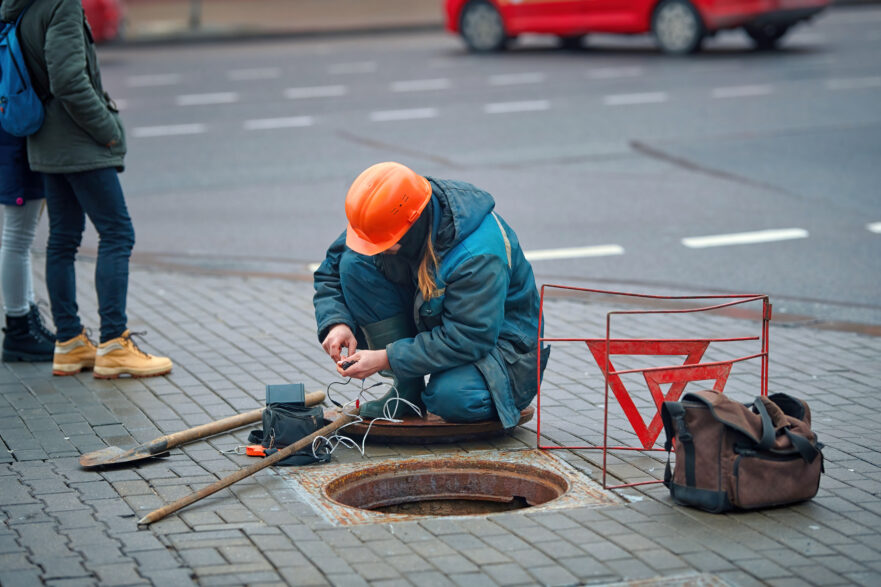Underground Utility Locating Services
At Wood Inspection Services, we understand the importance of underground utility locating for all types of projects. Without accurate detection of buried utilities, such as gas, water, or electrical lines, the risks of damage or injury can be substantial. That’s why we offer a range of underground utility locating services to help ensure the safety and success of your project.
Our process starts off with traditional electromagnetic (EM) location equipment, which allows us to quickly and accurately detect visible utilities. This equipment can detect the electromagnetic signals emitted by buried utilities, giving us a rough idea of their location and depth. Once we’ve located the visible utilities, we use this information to mark them out on the surface.
But our services don’t stop there. To provide a comprehensive view of what lies beneath the surface, we also offer ground penetrating radar (GPR) scanning. This technology uses high-frequency radio waves to create a detailed image of what lies beneath the ground, including both visible and non-visible utilities. That data is then compiled into a 3D map that you can use for analysis.
At Wood Inspection Services, our goal is to provide our clients with the most accurate and reliable information possible. By using the most sophisticated underground utility locating services technology, we provide a complete picture of what lies beneath the surface, allowing our clients to move forward with their projects with confidence.
Whether you are planning a new construction project or need to locate buried utilities for maintenance purposes, we are here to help. Contact us today to learn more about our private utility location services.
Utility Mapping and Surveying
The goal of our utility mapping and surveying is to help our customers increase efficiency, reduce risk, and lower costs with the most accurate data about what’s under the surface.
Electromagnetic Locating (EML)
EML is a non-invasive technology that utilizes electromagnetic signals to locate buried utilities underground. These signals can be generated by the flow of electric current through power cables or metallic pipes, allowing us to accurately identify and map out the location of these utilities.
EML is one of the first steps we take in utility mapping and surveying because it helps us quickly locate visible utilities like power lines and pipes. From there, we can mark out locations on the surface so they don’t get damaged during the excavation process. EML provides reliable information to our customers about the location and depth of utilities so they can feel confident in moving forward with their projects.
Ground Penetrating Radar (GPR)
GPR uses high-frequency radio waves to develop a detailed image of subsurface structures, including buried utilities, concrete, and soil layers. Our team of experienced professionals uses specialized GPR equipment to scan the subsurface and create a 3D map of the area.
This allows us to identify and locate both visible and non-visible utilities, such as plastic pipes or non-conductive cables, that may have been missed by EML methods. GPR can also be used to locate voids, rebar, and other features in concrete structures. With GPR, clients experience improved efficiency, cost savings, and an overall safer survey of buried utilities.
Utility Verification
Our utility verification services involve a comprehensive assessment of the location and condition of buried utilities in a specific area. Utility verification is done to ensure all utilities in the area have been accounted for. Utility verification will confirm that our clients are complying with applicable regulations and standards, saving money and preventing costly repairs due to accidental damage, and making the overall work site much safer.
SUE (Subsurface Utility Engineering) Services
Our subsurface utility engineering services allow for more informed decisions during construction and excavation projects. Working with a professional SUE team like us at Wood Inspection Services will make sure you’ll finish your project on time without having to worry about any damage to utilities.
There are four levels of SUE:
Level D: This is also referred to as a desktop utility records review and it involves reviewing previous utility records such as construction plans.
Level C: Level C is the utility designating level and it involves non-invasive methods like EML and GPR to locate utilities.
Level B: This level is also known as utility mapping and it provides an accurate and detailed analysis of the depth, size, and location of utilities underground.
Level A: Level A is utility surveying and it’s known as the most accurate level for mapping out subsurface utilities.
Private vs Public Utility Locating
Navigating the intricate network of underground utilities can be a daunting task, especially when it comes to distinguishing between public and private services.
Here’s the lowdown: Public utilities are those that run up to the street, while private utilities are located between the meter and your building. Unfortunately, the responsibility of marking private or non-member utilities falls on the property owner, and Texas811 won’t do it for you. That means, without the help of a reliable contractor, you could be risking an unexpected excavation.
But that’s where Wood Inspection Services comes in. Our team of experts can provide a comprehensive evaluation of both private and public utilities, ensuring that all underground lines on your property are located and marked accurately. From unused lines to vital infrastructure, we leave no stone unturned.
We understand that safety is paramount, and we’re committed to providing reliable and accurate information to keep you and your property safe from costly and dangerous excavation mistakes. Don’t let the underground maze of utilities keep you up at night. Let our skilled team at Wood Inspection Services be your guide. Visit our private vs public utility services page to learn more about the difference between public and private utility services.

